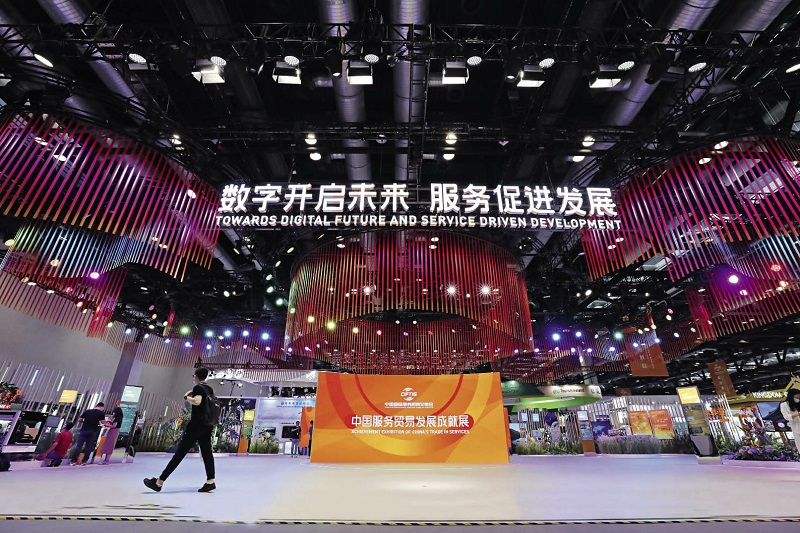On the evening of September 2, Chinese President Xi Jinping announced, via video link at the China International Fair for Trade in Services (CIFTS), China’s new measures to deepen reform and open its doors wider to the outside world. He expressed China’s determination to pursue innovative development and an increased level of opening up, as well as its willingness to share development opportunities with the rest of the world.

The National Convention Center, one of the venues for the 2021 China International Fair for Trade in Services (CIFTIS), is fully prepared for the grand fair on September 1.
New Drivers of Global Trade and Economic Growth
The global economy has become more service-oriented than ever before, and trade in services has become an important area for economic and trade cooperation among countries.
From 2009 to 2019, the average growth rate of global services exports was 5.4 percent, higher than that of the global GDP (2.8 percent) and the growth rate of goods exports (4.2 percent). In 2020, due to the impact of COVID-19, global exports of services reached US $4.99 trillion, down 19.8 percent year-on-year. The total trade in services accounted for 21.6 percent of world trade, and the proportion of trade in services is expected to rise to 50 percent by 2040, according to the WTO.
Today, with the quick evolution of science and technologies, the iterative innovation and application of digital technology are deepening. According to the World Trade Report 2020, since the last financial crisis, about 115 countries have launched strategic initiatives such as “industry 4.0” and “digital transformation.” The development of Internet technology and digital exchange technology has promoted the emergence and development of new economic activities based on big data, cloud computing, and social networks, improved the “tradability” of services, and expanded the scope and content of trade in services.
The Internet is deeply integrated with a growing number of industries, including retail, entertainment, publishing, leisure, finance, health, and education. The digitization and outsourcing of services are accelerating, and new forms and models of business such as cross-border e-commerce, digital content, search engines, social media, cloud computing, and digital payment are emerging in large numbers.
The COVID-19 has dealt a heavy blow to global trade in services, but it has greatly accelerated the digitization of trade in services, brought new opportunities for structural adjustment and development of a new type of trade in services, and spawned new business forms and models, such as telemedicine, shared platforms, and collaborative working.
As the establishment of global rules for trade in services at the multilateral level is blocked, developed countries led by the United States, the European Union, and Japan are actively building rules for trade in services at the bilateral and regional levels.
At the same time, with the rise of developing countries as a whole, their capacity to participate in and guide the building of the global economic governance system, including rules on trade in services, has significantly increased. Rules related to service market access, digital trade, intellectual property protection, competitive procurement and competition policies have become important topics in international economic and trade negotiations, therefore, to free and facilitate service trade has become a key part in high-standard free trade agreements.

The Shougang Industrial Park in Beijing, another venue of the 2021 CIFTIS, opens to visitors. One visitor is experiencing ski machines from Austria on September 4, 2021.
Highlights of China’s Trade in Services
While the global trade in services continues to develop, China’s service trade is also growing bigger. During the 13th Five-Year Plan period (2016-2020), China’s imports and exports of services totaled US $3.6 trillion, up 29.7 percent year-on-year, with exports up 21.6 percent and imports up 34.7 percent. In 2014, it made a historic leap forward, ranking second in the world in terms of total volume. Now it ranks second only to the United States.
Due to the impact of COVID-19, China’s trade in services decreased by 15.7 percent year-on-year in 2020, seeing a one percent drop in exports and a 24 percent drop in imports; but China’s export of services ranked fourth in the world, up one place from 2019. From January to June 2021, China’s trade in services grew by 6.7 percent year-on-year, basically returning to the level of the same period in 2019, taking the lead in the world in recovery.
Since the 13th Five-Year Plan period, the average growth of China’s service exports has been significantly faster than that of its imports, and the service trade deficit has continued to narrow. In 2020, the service trade deficit was US $100.46 billion, down 53.7 percent from 2015.
With high-quality development of China’s service trade, the industry structure has also been optimized. In 2020, China’s imports and exports of knowledge-intensive services reached US $294.76 billion, accounting for 44.5 percent of its total trade in services, up 24.1 percentage points from the end of 2015.
Meanwhile, the share of transactions of traditional services dropped from 68.5 percent to 50.2 percent. Knowledge-intensive services have become the main driving force for China’s trade in services, with total import and export volume of knowledge-intensive services contributing 1,445.2 percent to the total trade in services during the 13th Five-Year Plan period.
It is worth mentioning that the regional distribution of China’s trade in services has become more balanced since the 13th Five-Year Plan period. A network of innovative development platforms featuring the “one pilot, one demonstration park, and multiple bases” concept has been basically established.
The service trade in the eastern region of China is leading the country, while that in the central and western regions is developing rapidly. In 2019, the imports and exports of services in Beijing, Shanghai, and Guangdong, the three core areas of service trade, reached US $475.98 billion, accounting for 60.6 percent of China’s total service imports and exports. In 2020, trade in services between China and countries and regions along the Belt and Road totaled US $84.47 billion, accounting for 12.8 percent of the total, up 0.5 percentage points from 2015.
Today, trade in services has gradually become a new engine for China’s increased level of opening up and a new core for high-quality development of the real economy. In 2020, China’s service exports accounted for 9.8 percent of its total exports, one percentage point higher than that of 2015. Foreign investment in the service sector accounted for 78.5 percent, 8.7 percentage points higher than that of 2015. The number of service outsourcing employees was about 12.91 million, an increase of 73.3 percent over 2015.
Although the global trade in services is still faced with unstable and uncertain factors, such as the COVID-19 and limited flow of people and logistics, it is continuing to see rapid growth.
Domestically, China has entered a new stage of development, implemented the new development philosophy, and accelerated the building of a new development pattern. Meanwhile, the proportion of the service sector in the national economy has been increasing, and service consumption has increasingly become the main driver of household consumption. The growth of people’s demand for quality services has boosted the scale and quality of service trade. Internationally, due to the epidemic, digital technologies are developing quickly, conducive to the development of trade in services.

The Iran exhibition area at the 2021CIFTIS, on September 4, 2021.
A Boost to Global Economic Recovery
Against the background of the grim and complex COVID-19 situation worldwide, and the recovering global economy, holding an important event like the CIFTS is of great significance to the development of both China’s and global trade in services.
After years of development, the fair has become an important platform for China’s opening-up. In the face of global unilateralism, protectionism, and hegemonism, China hosted it as scheduled, which is a positive signal of China’s commitment to promoting economic globalization and deepening international economic and trade cooperation, and demonstrates China’s initiative to take its responsibility as a major country.
At present, China has entered a new stage of development, and its advantages as a super-large market will be further strengthened, while the coordinated development of the domestic and international markets will be promoted. The successful hosting of the fair will further deepen international cooperation in the field of services, better promote the “dual circulation” development pattern, activate the growth momentum of trade in services, and promote high-quality development of trade.
As the largest comprehensive exhibition in the field of global trade in services, the CIFTS will help build consensus among major countries on promoting the openness of the service sector and the development of trade in services, and taking practical actions to restore global trade in services.
On the one hand, a series of forums and conferences have been held this year to promote dialogues on multilateral cooperation in a bid to facilitate global trade in services. On the other hand, with the support of advanced digital technologies, the fair was held both online and offline to promote exchanges and negotiations.
From President Xi’s speech at the CIFTS, it is clear that by accelerating the building of a new system for an open economy, China will continue to open its service sector wider and promote innovative development of trade in services.
China’s trade in services is expecting a big growth in the future. With an improved structure, its role in the national economy will continue to be prominent. The world will also get more opportunities from it.
NIE PINGXIANG is deputy director and a researcher at the Institute of International Trade in Services, China Academy of International Trade and Economic Cooperation.